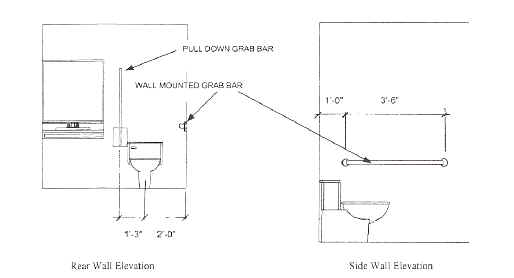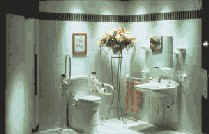Best Practices in the Design of Toileting and Bathing Facilities for Assisted Transfers
Location. The ADAAG L-shaped grab bar configuration that includes a bar on the sidewall and one on the rear wall behind the toilet was consistently considered inadequate to meet the needs of people requiring assistance. As Gregory Scott, AIA, partner in RLPS, responded:
"…the major challenge with the implementation of ADAAG, is not with excessive space requirements or even required clearances; but more with achieving non-institutional appearances and being required to install assistive devices, such as wall-mounted grab bars at toilets, that serve no useful purpose for our age group [persons 78+ years of age]. We often end up installing redundant grab bars; one set to meet guidelines, the other set to meet the true needs of the resident. We are discovering that grab bars mounted at the recommended heights and distances from the toilet, both side and rear locations , are too far away to be effective for ‘self’ assistance. The seat mounted grab rail or fold-away models can place the ‘assistance’ where it is useful."
Subsequently, the rear grab bar behind the toilet was omitted in all configurations intended to accommodate assisted transfer. Similarly, the sidewall grab bar was often omitted. When this grab bar was used (e.g. Memorial Hospital of Iowa County, Dodgeville, WI, Nelson Tremain Partnership), it was intended to be used as a support for a standing individual during dressing and a swing away grab bar was provided on the opposite side of the toilet (Figure 10).

Figure 10. Grab Bar Location at Memorial Hospital of Iowa County, Dodgeville, WI (Nelson Tremain Partnership)

Figure 11. Location of Swing Away Grab Bars (Linido grab bars pictured here)
Rear-mounted (either floor or wall), swing away (or fold up) grab bars (e.g., Linido or Bobrick) on both sides of the toilet were the most popular configuration to accommodate one or two person-assisted transfers as well as independent toileting (Figure 11). Those designs that did not utilize these grab bars either used straddle bars (non-movable) that flanked both sides or simply applied ADAAG for compliance purposes and then added additional grab bars to meet the needs of the clients. Rob Pfauth, AIA, a design architect at OWP&P stated that:
"grab bars on both sides of water closets that either swing up or away obviously afford the ability for one or more caregivers to stand beside the resident and brace them while mounting or dismounting the toilet. Yet these grab bars, when in the extended position alongside the water closet provide superior leverage to the frail older adult, dependent on his or her waning upper body strength, in lowering or lifting themselves during independent toileting. Installing grab bars on both sides is important, particularly for stroke victims with hemiplegia, as a conventional sidewall grab bar on the "wrong" side is virtually useless for transferring."

User Comments/Questions
Add Comment/Question